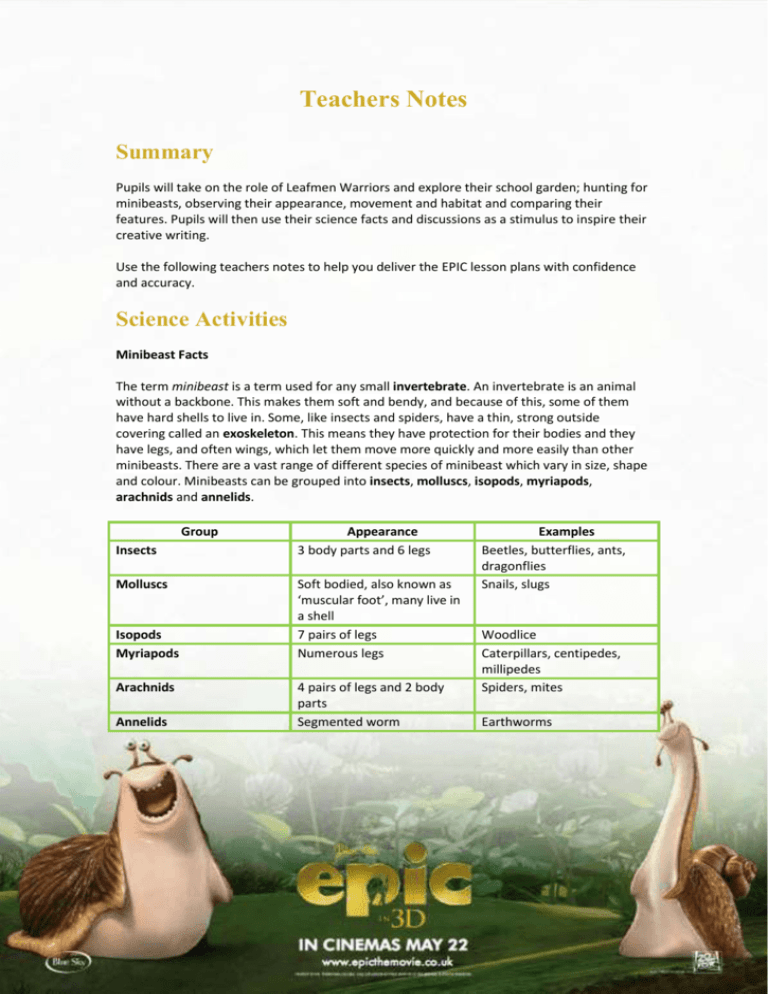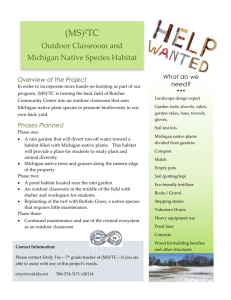Teachers Notes Summary - National Schools Partnership
advertisement

Teachers Notes Summary Pupils will take on the role of Leafmen Warriors and explore their school garden; hunting for minibeasts, observing their appearance, movement and habitat and comparing their features. Pupils will then use their science facts and discussions as a stimulus to inspire their creative writing. Use the following teachers notes to help you deliver the EPIC lesson plans with confidence and accuracy. Science Activities Minibeast Facts The term minibeast is a term used for any small invertebrate. An invertebrate is an animal without a backbone. This makes them soft and bendy, and because of this, some of them have hard shells to live in. Some, like insects and spiders, have a thin, strong outside covering called an exoskeleton. This means they have protection for their bodies and they have legs, and often wings, which let them move more quickly and more easily than other minibeasts. There are a vast range of different species of minibeast which vary in size, shape and colour. Minibeasts can be grouped into insects, molluscs, isopods, myriapods, arachnids and annelids. Group Insects Molluscs Isopods Myriapods Arachnids Annelids Appearance 3 body parts and 6 legs Soft bodied, also known as ‘muscular foot’, many live in a shell 7 pairs of legs Numerous legs 4 pairs of legs and 2 body parts Segmented worm Examples Beetles, butterflies, ants, dragonflies Snails, slugs Woodlice Caterpillars, centipedes, millipedes Spiders, mites Earthworms Minibeast Hunt Minibeasts (or invertebrates) are found in a diverse range of terrestrial and aquatic habitats and there are many different ways of collecting them. The methods detailed below are suitable for pupils to hunt for invertebrates in a garden habitat. When collecting minibeasts to observe, pupils should be reminded to treat them with care and sensitivity, using appropriate equipment, as some minibeasts are very delicate. It would be beneficial to source a selection of minibeast texts to support classification of minibeasts found. Searching on the garden floor: Observe the minibeasts where they are found, examining the habitat and how they move. They could then carefully pick up the minibeast using a spoon and transfer into a container for a more detailed look at their body using a magnifying glass. Remind pupils to put the logs and stones back exactly as they found them and that the invertebrates should be placed very carefully under logs. Health and Safety - The pupils should lift and replace logs carefully, watching out for fingers and toes. Larger logs should be lifted by adults using the correct lifting position. Digging underground: Pupils could carefully dig areas of soil using gardening tools. Health and Safety - Sites unlikely to have been contaminated with dog faeces should be chosen. Ensure that pupils wash their hands after handling soil etc. Looking on plants and shrubs: Pupils could carefully search in plants and shrubs for minibeasts. Observing how they move and what they are doing. E.g. Are they eating/collecting pollen? Health and Safety - Remind pupils of the dangers of stinging insects and plants. Pitfall Traps: Pitfall traps are used to catch small, crawling insects. They can be set up and left overnight to catch nocturnal species. All minibeasts caught should be released unharmed. Health and Safety – Make sure all pitfall traps are clearly marked so no one steps in accidentally. Pooters: A pooter is used to catch small insects. The user breathes in through the mouthpiece which has a piece of net covering the end. The insects are sucked into the holding chamber via the inlet tube. Sweep nets: Sweep nets are used in areas of long grass to catch minibeasts. They can also be used in ponds. Using a sweep net, pupils should make broad long sweeps of the net through long grass or nettles. After sweeping the inside of the net can be examined for creatures. Health and Safety – Discuss safe methods of sweeping the net to avoid hitting other classmates. Be careful when working near stinging nettles. Common Garden Minibeast Classification Insects: Name: Diet: Habitat: Predator: Ant Proteins and sugars like honeydew Colonies underground Ground beetles, humpback flies, woodpeckers Name: Diet: Habitat: Predator: Bumblebee Nectar, honey Beehive, air, flowers Birds, spiders, ants, wasps, frogs, toads, rickets, birds, ants, grasshoppers, spiders Name: Diet: Habitat: Predator: Butterfly Liquids including flower nectar In the air and on plants Ants, parasitic flies, birds, wasps, snakes, rats, toads, frogs, lizards Name: Diet: Habitat: Predator: Damselfly Small insects e.g. midges Near ponds and areas of water Birds, spiders, toads, frogs Name: Diet: Habitat: Predator: Dragonfly Small insects e.g. midges Near ponds and areas of water Birds, spiders and frogs Name: Diet: Habitat: Predator: Name: Diet: Earwig Small flies and plants Dark, damp conditions. E.g. under rocks and logs Toads, frogs, birds Predator: Grasshopper Plants in the grass family such as corn, wheat and barley Meadows, fields, rainforest, mountains, and deserts Birds, beetles, rodents, reptiles, spiders Name: Diet: Habitat: Predator: Greenfly Nectar rich flowering plants Air and on plants Ladybirds, lacewings, hoverflies Name: Diet: Habitat: Predator: Ground beetle Earthworms and slugs Under rocks, stones and dead leaves Toads, frogs Name: Diet: Habitat: Predator: Ladybird Aphids, greenfly and mites Trees, grasses and bushes Birds Habitat: Molluscs: Name: Diet: Habitat: Predator: Name: Diet: Habitat: Predator: Slug Plants In a wet moist areas. E.g. under a rock, and after it rains in the grass or garden Birds, ground beetle, frogs, toads Snail Plants Damp places among plants and under stones Birds Isopods: Name: Diet: Habitat: Predator: Woodlouse Rotting wood Under damp logs Toads, frogs, centipedes, spiders, millipedes Name: Diet: Habitat: Predator: Caterpillar Leaves On leaves Birds and wasps Myriapods: Arachnids: Name: Diet: Habitat: Predator: Harvestman Small insects Tree trunks Birds, toads, frogs Name: Diet: Habitat: Spider Flies and insect pests Spiders can make webs practically anywhere Birds, toads, frogs Predator: Annelids: Name: Diet: Habitat: Predator: Earthworm Rotting matter and soil In soil Birds, beetles, toads, frogs, hedgehogs, mice, moles Key Word Glossary Annelids Arachnids Carnivore Consumer Exoskeleton Habitat Herbivore Insects Invertebrate Isopods Micro-habitat Molluscs Myriapods Omnivore Species Segmented worm. E.g. earthworms 4 pairs of legs and 2 body parts. E.g. spiders, mites An animal that eats meat An animal that derives its food from another organism – plant or animal An external hard body covering, providing protection and support. Many invertebrates have exoskeletons The place where an organism lives and finds food, water and shelter (the non-living surroundings) An animal that eats plants 3 body parts and 6 legs. E.g. beetles, butterflies, ants, dragonflies An animal with no backbone 7 pairs of legs. E.g. woodlice Micro-habitats are parts of larger habitats. A log is an example of a micro-habitat and many minibeasts may be found living underneath it. The log may, however, be in a wood or a garden in which a larger community lives. Soft bodied, also known as ‘muscular foot’, many live in a shell. E.g. snails, slugs Numerous legs. E.g. centipedes, millipedes An animal which eats both plants and other animals A particular type of living thing. Over one million species of insect have been recorded by entomologists Literacy Activities Pupils will use role play to develop a creative story about a magical adventure into a garden world. They will create their own setting for the story, meet characters and help minibeasts who are in trouble. Pupils will then use the outcomes from the drama activity to plan and write their story. Throughout both activities, create a ‘word wall’ displaying power vocabulary for pupils to use in their independent writing. When pupils meet a minibeast in trouble through Teacher in Role section take on your role whole-heartedly. A role signifier is often useful so pupils know when you are in and out of character (E.g. by wearing a hat when in role). When pupils are working as a group remind them to take it in turn to speak, giving everyone a fair chance to share their ideas. They must listen intently, comment on each other’s ideas and decide as a group how they will advise the minibeasts in danger. EPIC Competition - Win an EPIC garden for your school! The EPIC garden competition is a perfect way to reward pupils for all their hard work. This could be set as homework, completed in golden time or completed at home with family and friends! EPIC Prizes All pupils need to do to see their dreams become reality, is design their idea of an EPIC school garden! The most EPIC design will be brought to life as a real garden at your school. Exclusive EPIC film goodies, an iPad Mini and £50 GapKids vouchers are also up for grabs for the winner and ten lucky runners-up. Hints and tips for the competition You could introduce the competition, using the pupils competition leaflet. Watch the EPIC movie trailer (via www.youtube.com/watch?v=-xu3JLXfuwQ) as a class and discuss: What could you see in the EPIC garden? Would you like to have an EPIC garden in our school? Discuss as a class where the EPIC garden could be positioned on the school grounds. Take a walk around the outside space or ask pupils to consider this while outside at break time. Discuss what features they think would make an EPIC garden. Encourage pupils to think about researching interesting garden features using the internet, by visiting a garden centre or looking in texts (such as magazines). To get started, you could discuss the following types of gardens and features: Vegetable garden Herb garden Compost heap Greenhouse Sensory garden Pond Bird table What’s your favourite flower? Make sure there is space to plant it! Create a class mind map of garden features they would like their EPIC garden to include. Where would you like to sit? Would you like any interactive features? Do you think it’s important to have a vegetable garden? What colour plants would you like? We have been observing minibeasts in their natural habitat ... do we need to consider their needs? Move onto discussing how pupils could make their EPIC garden design stand out above the rest. Which art medium could you use? Encourage pupils to think creatively about how their design will be truly EPIC. Add ideas to your class mind map.



![afl_mat[1]](http://s2.studylib.net/store/data/005387843_1-8371eaaba182de7da429cb4369cd28fc-300x300.png)




